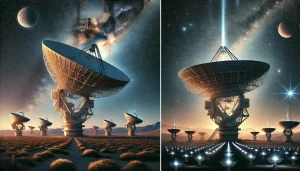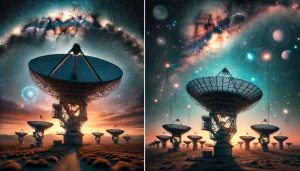Space, the final frontier, has always beckoned humanity with its countless mysteries and boundless expanse. As we gaze up at the night sky, we see stars that twinkle and planets that shimmer, but what lies beyond the capabilities of our naked eyes? Enter the world of radio telescopes, marvels of modern technology that allow us to peer deeper into the universe than ever before. These incredible instruments are revolutionizing the way we explore the cosmos, revealing secrets hidden in the radio waves that traverse the infinite vacuum of space.

Exploring the Universe with Radio Telescopes!
Radio telescopes are like giant, cosmic ears, attuned to the subtle whispers of the universe. Unlike optical telescopes, which capture visible light, radio telescopes detect radio waves emitted by celestial objects. This technology opens up a whole new realm of observation, enabling us to explore regions of space that are otherwise obscured by dust and gas. Imagine being able to hear the faint hum of a distant galaxy or the rhythmic pulse of a spinning neutron star – that’s the magic of radio astronomy!
The construction of radio telescopes often involves massive dishes or arrays of smaller antennas spread across vast distances. The iconic Arecibo Observatory in Puerto Rico, with its 305-meter-wide dish, and the Very Large Array (VLA) in New Mexico, featuring 27 antennas stretching over 36 kilometers, exemplify the grandeur of these engineering marvels. These colossal structures work in unison to capture and amplify faint radio signals from the depths of space, providing scientists with invaluable data about the universe’s composition and behavior.
Radio telescopes have played a pivotal role in some of the most groundbreaking discoveries in astrophysics. For instance, the discovery of pulsars – rapidly rotating neutron stars emitting beams of radio waves – has provided insights into the extreme conditions of collapsed stellar remnants. Similarly, the detection of cosmic microwave background radiation, a relic of the Big Bang, has helped us piece together the early history of the universe. Through radio telescopes, we’re not only exploring the cosmos but also delving into its very origins.

Decoding Cosmic Mysteries One Signal at a Time
The universe is brimming with enigmatic phenomena, and radio telescopes are our key to unlocking these cosmic puzzles. One of the most intriguing signals that astronomers study is the Fast Radio Burst (FRB). These are incredibly powerful and brief flashes of radio waves that originate from unknown sources billions of light-years away. Every FRB detected brings us closer to understanding their origin, whether it be from exotic astrophysical objects or perhaps even advanced alien civilizations.
Additionally, radio telescopes have been instrumental in mapping the distribution of hydrogen in the universe. Hydrogen, being the most abundant element, emits a specific radio frequency that can be detected and analyzed. By studying these signals, astronomers can trace the structure and evolution of galaxies over cosmic time. This information helps us understand how galaxies form, merge, and evolve, shedding light on the grand tapestry of the universe.
Moreover, radio telescopes are at the forefront of the search for extraterrestrial intelligence (SETI). By scanning the skies for unusual radio signals, scientists hope to detect signs of intelligent life beyond Earth. The famous WOW! signal, detected in 1977, remains one of the most tantalizing pieces of evidence in this quest. Though its origin remains a mystery, it ignites our imagination and fuels the hope that one day we might make contact with other civilizations. Radio telescopes, with their ability to listen to the cosmos, keep this dream alive.
Radio telescopes are more than just tools; they are gateways to the unknown, allowing us to explore the universe like never before. By listening to the radio waves that fill the cosmos, we uncover secrets that have been hidden for eons, transforming our understanding of the universe and our place within it. As technology advances and new radio telescopes come online, there’s no telling what extraordinary discoveries await us in the vast expanse of space. With each signal decoded and each mystery unveiled, we are reminded of the infinite wonders that lie beyond our tiny blue planet. Let us continue to listen, explore, and dream about the boundless possibilities that the universe holds.








